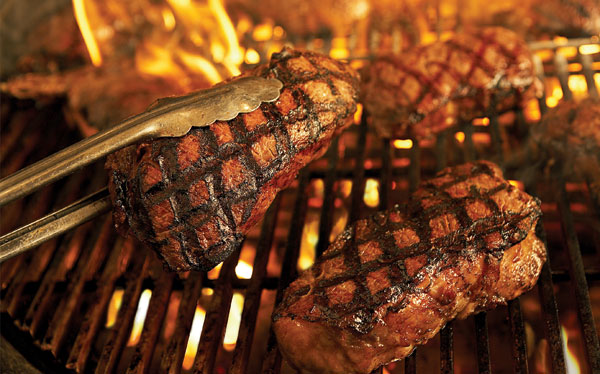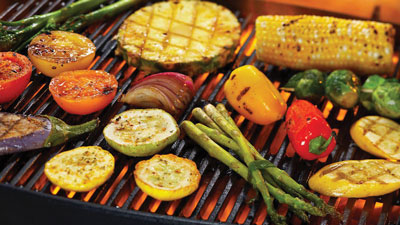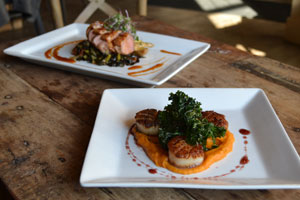Get Grillin’
Ah, the signs of summer. Birds chirping, flowers blooming, kids playing and wait for it … the wafting smell of something fabulous on the grill. From meat to vegetables to fruit and desserts, the options are endless, say area grillers.
 “I love to grill anything and everything that I can. Especially after winter,” says Robert Stanley, general manager of Famous Dave’s of Appleton. “I am always experimenting with new cuts of meat and recipes.”
“I love to grill anything and everything that I can. Especially after winter,” says Robert Stanley, general manager of Famous Dave’s of Appleton. “I am always experimenting with new cuts of meat and recipes.”
Looking for some ideas to get the fires burning? Take a look at what four Fox Valley grillers suggest.
Grilling vs. barbecuing
“Grilling is a fast, high-heat cooking process mainly used for burgers, steaks and brats,” explains Anthony Falbo, owner of Dickey’s Barbecue Pit in Appleton. “Smoking or true barbecue is a low-temp, long cooking process with larger cuts of meat that usually have a higher fat content. So, in order to make the meats tender, they have to be cooked for a very long time. We smoke our beef brisket and pork shoulders (pulled pork) for 13 to 14 hours overnight in our hickory wood burning pit.”
Grilling puts direct flame cooking on your meat at 500-600 degrees, while barbecuing, or smoking, keeps meat at a low temperature of 200-275 degrees, Falbo notes.
Good cuts
When selecting a good cut of meat, it’s important to go lean, say area grillers. Don’t, however, overlook the fat.
“This helps keep the meat moist while grilling and adds to the flavor,” says Stanley. “You always want to start cooking the meat with the fat side up, which allows the juice to be absorbed into the rest of the meat.”
Falbo, a fan of grilling rib-eye steaks and brats, buys his meat fresh.
“You want to buy fresh, never frozen meats,” he says. “You want to make sure they have a nice marbling, which is the fat to meat ratio. Remember, the fat is where the flavor is at.”
Mark Dougherty, owner of Mark’s East Side in Appleton, opts for Certified Angus Beef and clarifies what to look for in marbling. Consumers should look for pinhead-size flecks of fat throughout the meat, he says. An 81/19 or 80/20 ratio is a good place to start, suggests Shane Johnson, kitchen manager at Milwaukee Burger Company in Appleton. He learned to grill from his dad, and his grandfather was a butcher.
“If you go to a local market, butcher shop or farm, they have one job and that’s to supply you with the meat,” he says.
If you’re not sure what to put on the grill, there are a number of options to consider.
Stanley prefers St. Louis-style cut ribs because of their meat to fat ratio. While pork chops, chicken, burgers, steaks and chicken also work well.
“It’s the most pliable. You can do a lot with it on the grill,” says Johnson of chicken.
According to Stanley, burgers on the grill should receive two quarter turns on each side and the more you flip a burger during the cooking process, the smaller it becomes. Pressing down on the patty also should be avoided.
If you’re looking for a burger that’s outside the box, consider buffalo, elk, black bean, turkey or a stuffed patty, says Johnson who encourages grillers to “take flavors and push them a little.” For stuffed burgers, take two regular-sized patties and form the meat around your preferred filling, press the edges and flatten it out. They will take longer to cook and can bust open, Johnson warns. His personal favorite is a loaded baked potato burger. Use shredded cheese, finely diced French fries and cooked green onion for your filling. Top the cooked patty with sour cream and bacon.
As for steaks, Stanley says, “the thicker, the better.” He prefers porterhouse and T-bones with a 1- to 2-inch cut.
Preparation tips
If you’re not sure what to put on your meat before you put it on the grill, sticking to the basics is a good place to start. Falbo recommends using salt and pepper so you can still taste the meat.
“Pre-seasoning and marinating your grilling meat beforehand will always add something extra to your meal,” says Stanley. “This allows the flavors to penetrate your food and enhances the flavor of any meat that you throw on your grill.”
“You can close your eyes and pull out the first three things that you pull out of the spice drawer,” adds Johnson. Course brown pepper, sea salt, garlic and onion powder are good starters, he shares.
“You can’t go wrong with it. It’s meant to be,” he says, adding to just use a pinch. “Nothing beats a good burger with salt and pepper. … Seasoning, it’s a science. You need to develop it and see what goes with what.”
Consider marinating pork chops and chicken ahead of time for additional flavor and moisture.
“I would recommend getting chops that are ¾- to 1-inch thick,” says Stanley. “The thin ones tend to dry out quick and are best for in home on the stove top rather than on the grill.”
“The longer it sits, the better the flavor profile,” adds Johnson who suggests mixing the meat with the marinade on Friday night for a Sunday afternoon gathering.
When it comes to pork, ribs and chicken, Dougherty suggests brining it before grilling. An easy recipe to try is 1⁄4 cup sugar and 1⁄4 cup Kosher salt mixed with a gallon of water. Before grilling, a rub also can be used on poultry and the cavity can be stuffed with a mix of carrots, celery and onion. For a medium-size chicken, cook at about 250 degrees in indirect heat for two hours, Dougherty says.
“Let the seasonings have a chance to seep into the meat so it doesn’t come right off,” he adds.
Always make sure your meat also is 100 percent thawed before grilling.
“Cooking frozen meat on the grill will get overdone and burnt on the outside while the center remains raw and undercooked,” notes Stanley. “Plus, as the frozen center thaws, it releases the water, which will wash away any seasoning that’s put on your product.”
Well done
Falbo suggests using the finger test to determine whether red meat is ready to come off the grill. To get an idea of what “medium” should feel like, touch your thumb and middle finger together and feel the fleshy part near your thumb. For “medium well,” touch your thumb to your ring finger and for “well done,” your thumb to pinky finger. When in doubt, cut the meat open to check for doneness. One plate should also be used to take meat out to the grill and another for when it’s done. Wash your hands in between handling food.
“You don’t need a toolbox to grill. I’ve used two sticks before,” says Johnson who recommends having serving plates, a set of tongs, spatula, grilling forks and thermometer to get started.
Chicken, on the other hand, should be measured by temperature and register 165 degrees in the fattest part of the meat. Fish should be cooked to 145 degrees.
“One of our family favorites is to put the whole tenderloin on the grill,” says Dougherty who cooks the front and back side of the meat on the grill until the middle is done to medium rare. That way, the further out you go to the edge of the meat, it should have cuts that also will be done to medium, he explains. Before taking the meat off the grill, he warms a platter and then transfers the meat to it, covering it with a clean towel to let it rest for five minutes. This will allow the meat to hold its juices before slicing. Dougherty recommends cutting it at an angle.
“You can feed a variety of doneness,” he adds. “We oil the meat to give it some adhesion properties.” Dougherty also adds garlic, along with salt and pepper to the tenderloin for extra flavor.
Gas or charcoal
Just as people have their favorites in grills, there’s also a debate over whether to use charcoal or gas when grilling.
“As far as a preference between charcoal and propane, I use both at home. It all depends on what mood I’m in,” says Stanley. “At the restaurant, we slow smoke our meat in a rotisserie smoker and grill using gas.”
“I prefer natural charcoal,” states Falbo. “It doesn’t add any unwanted flavors to what I am grilling. Propane and natural gas give some meats a bitter flavor and odor.”
For Dougherty, he prefers to use lump charcoal with no lighter fluid as it prevents ash and fillers from getting into food, he says. “Start with a good charcoal and go from there,” he says.
Experimenting is half the fun, Dougherty adds. Each griller needs to discover what works best for them. Wood chips and other products also are available.
“The flavor is amazing,” adds Johnson. “Charcoal is like your electric stove of grilling.”
Measure of success
So, what makes for a good grilling experience? Stanley stresses patience.
“Rushing your grilled items is what takes away from the flavor. Good things come to those who wait,” he says.
“Be sure not to overcook your meats or vegetables, there is nothing worse than over-grilled foods,” adds Falbo. “You don’t want to overcrowd your grill. You want to leave a 1⁄2 inch to an inch between your meat.”
He adds that meat needs room to cook evenly. Too much on the grill at once will trap heat and cause hot spots or burning.
Something different
One item that has fantastic flavor on the grill is portabella mushrooms, Stanley shares. “Even though it’s not meat, it is a great alternative,” he says. “I place them in a bowl of melted garlic  butter for around 5 to 10 minutes, put them on the grill. Cook for around 5 to 8 minutes on each side, depending on grill temperature and top with cheese. I use provolone, but whatever you prefer will work.”
butter for around 5 to 10 minutes, put them on the grill. Cook for around 5 to 8 minutes on each side, depending on grill temperature and top with cheese. I use provolone, but whatever you prefer will work.”
Falbo seconds experimenting with veggies, but also suggests fruits, such as watermelon and pineapple. Dougherty also likes peaches.
“When vegetables are grilled, the natural sugars are more evident and add great flavors to your grilled meats,” Falbo explains.
To spice things up beyond corn on the cob, try a stuffed jalapeno. According to Falbo, they’re simple to make. Start by cutting a jalapeno in half, then remove the seeds and ribs, and stuff with cream cheese. Finish by wrapping with bacon. Cook with indirect heat for about 35 minutes.
Dougherty also enjoys vegetables on the grill and opts for mixing broccoli and cauliflower in a grilling pan. He tumbles the grilled veggies in a bowl with some olive oil after and let the flavors sit.
Fish also can be cooked on the grill in a basket to help it from falling apart while pizza stones are a fun option, too. Breakfast items like ham steaks, sausages and bacon also shouldn’t be overlooked. For dessert, cookies, pudgy pies and s’mores are always fun.
“There is nothing more fun than grilling on a summer day with friends and family,” says Falbo.
“When you’re cooking out it should be for people, not just yourself,” adds Johnson. “It’s the social aspect.”
—FC











Leave a Comment